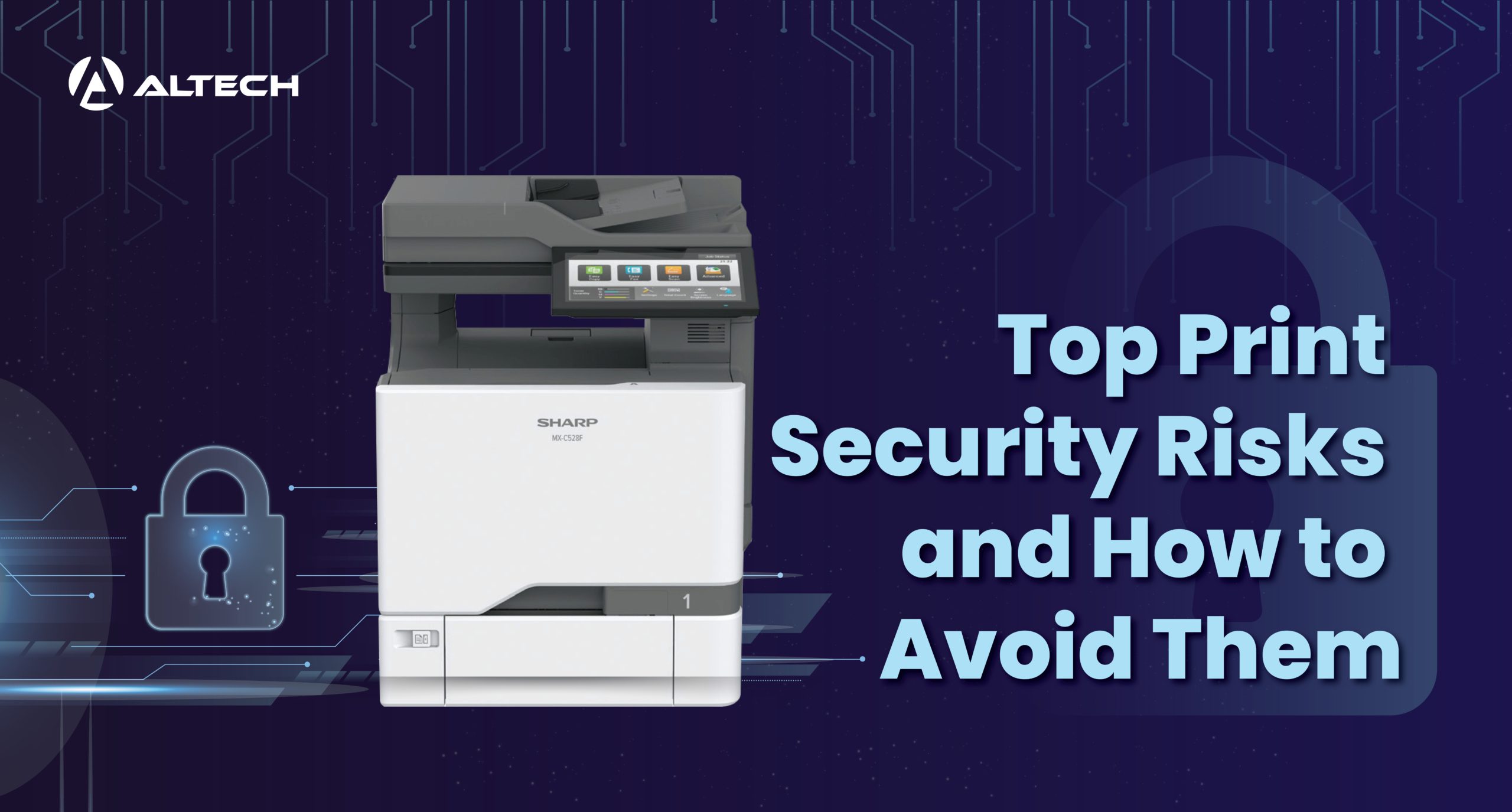Top Print Security Risks and How to Avoid Them

Introduction: Printers—The Silent Vulnerability
In today’s digital office, printers aren’t just machines that spit out paper—they’re powerful, connected devices. Most can store data, access networks, and even run their own software. That makes them a serious security concern.
Yet, many businesses still treat printers like simple tools. That’s a mistake. Just like computers, printers can be hacked. And if they’re not protected, they could expose sensitive data or even provide a backdoor into your network.
A 2018 HP study found that less than 2% of business printers were properly secured—even though printer-based threats had increased by 68% since 2016.
Let’s break down the major print security risks and how to avoid them.
Top Print Security Risks
1. Printers Store Sensitive Data
-
Modern printers often retain copies of documents in internal memory—even after printing.
-
This includes financial reports, employee records, and client data.
-
If someone gains access to this stored information, it’s a direct data breach.
How to avoid it:
-
Encrypt all stored data.
-
Regularly wipe printer memory.
-
Limit user access through authentication controls.
2. Network-Based Attacks
-
Printers are usually connected to internal networks, which makes them accessible to cybercriminals.
-
Hackers can intercept print jobs or exploit weak network configurations.
-
In one real-world case, nearly 28,000 printers were hijacked remotely by researchers to demonstrate how vulnerable these devices are.
How to avoid it:
-
Use firewalls and network segmentation.
-
Enable encryption for all print jobs.
-
Disable unnecessary network protocols like Telnet and AppleTalk.
More on network printing vulnerabilities
3. Outdated Firmware and Default Settings
-
Printers with old firmware are vulnerable to remote code execution.
-
Many printers come with default admin credentials like “admin” and “1234”—easily found online.
How to avoid it:
-
Regularly update printer firmware.
-
Change all default passwords.
-
Disable features and services you don’t use.
See firmware risks and mitigation
4. Mobile and Cloud Printing
-
Mobile printing adds flexibility—but also introduces new risks.
-
Malware on a smartphone or tablet can hijack print jobs or infect the printer.
How to avoid it:
-
Enforce secure mobile printing apps.
-
Use multi-factor authentication.
-
Monitor all external device connections.
Learn more on secure mobile printing
5. Human Error and Physical Access
-
People often forget to collect printouts, leave sensitive pages behind, or dispose of them improperly.
-
If printers are left in unsecured locations, someone could physically steal data—or even the printer itself.
How to avoid it:
-
Use pull-printing or secure release systems.
-
Shred all confidential documents before disposal.
-
Lock printers in secure, monitored areas.
Read about human-factor print risks
Real-World Print Security Breaches
Here are some key examples that highlight what can go wrong when print security is overlooked:
-
Sony Pictures (2014): Hackers leaked confidential data via compromised print systems. Total damage: $15 million.
Read the full story -
DNC Hack (2016): Attackers gained network access through a printer, eventually stealing sensitive emails.
Read the full story -
University of California (2019): Misconfigured print servers exposed data of over 300,000 individuals.
Read the full story
How to Secure Your Print Environment
To protect your business, implement these practical solutions:
Technical Safeguards
-
Use strong authentication: Require PINs, badges, or other forms of authentication before printing.
Learn about Secure Print Release -
Encrypt data: Apply encryption to data both in-transit and at-rest.
More on print data encryption -
Keep firmware updated: Install patches from the manufacturer to fix known flaws.
-
Segment the network: Isolate printers from critical systems using VLANs or subnets.
-
Monitor activity: Set up alerts for unauthorized print jobs or login attempts.
Policy and Training
-
Create a print security policy: Clearly outline responsibilities, procedures, and acceptable use.
-
Train employees: Make print security part of regular cybersecurity training.
Why staff training matters -
Enforce secure disposal: Shred unused documents; wipe devices before disposal.
-
Secure the physical device: Lock down printers and restrict access to authorized users only.
Consider Advanced Solutions
-
Managed Print Services (MPS): Considering Managed Print Services providers can be highly beneficial. MPS can proactively identify risks, enforce uniform security policies across the print fleet, and integrate print security seamlessly with the broader IT security strategy.
Explore MPS benefits -
Adopt Zero Trust: Adopting a zero-trust security framework for the print environment is a powerful approach. This principle, “never trust, always verify,” treats networked printers as potential risks rather than inherently trusted endpoints, requiring authentication and verification at multiple levels for every interaction. This approach is particularly crucial for supporting remote and decentralized workforces.
Zero Trust explained
Final Thoughts: Make Print Security Part of Your Cyber Strategy
Printers aren’t just office tools—they’re network-connected endpoints that can open the door to major security risks if ignored.
A secure print environment isn’t just about avoiding hacks. It’s about:
-
Protecting customer data
-
Meeting compliance standards (HIPAA, GDPR, etc.)
-
Preventing financial loss
-
Strengthening overall cybersecurity posture
It’s time to stop treating printers as harmless machines and start viewing them as critical parts of your infrastructure.
For a free consultation, contact us at https://wa.me/971569981942 or call us at +971 56 998 1942
